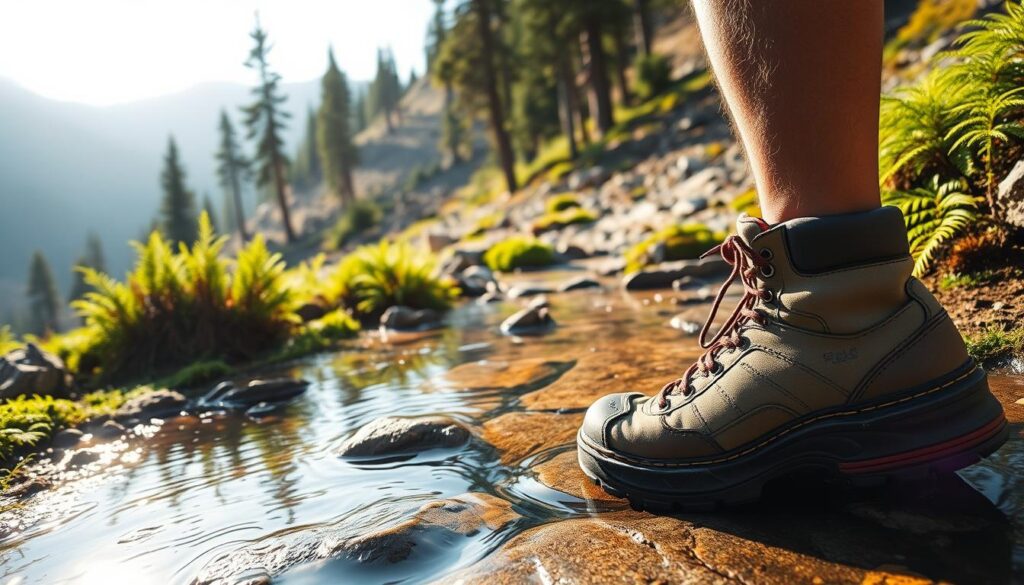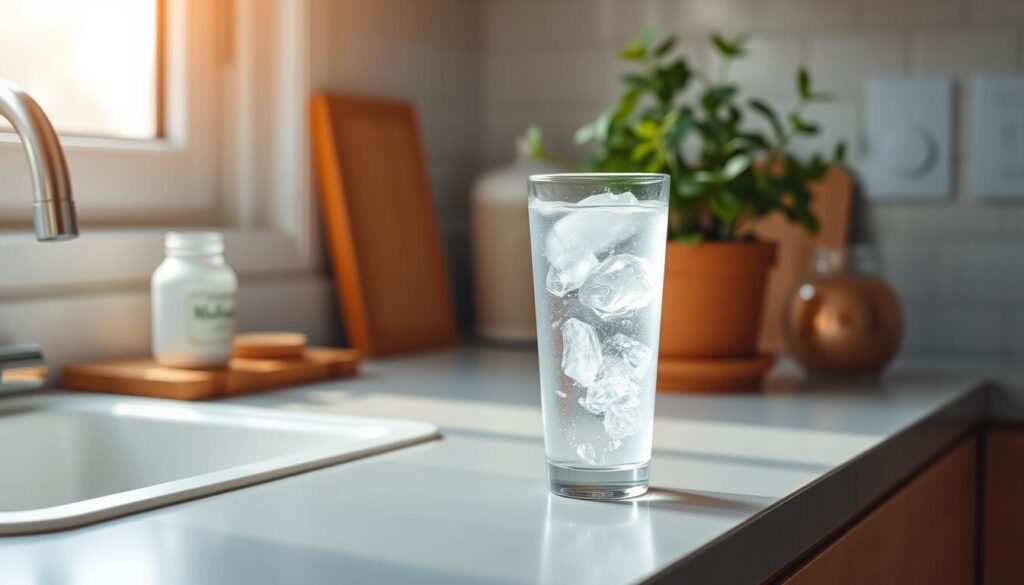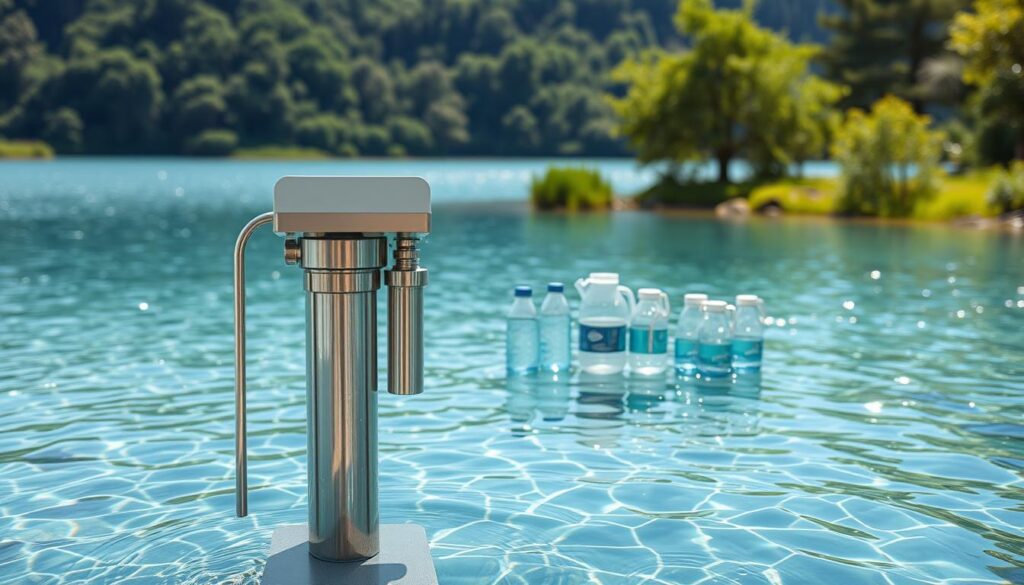When I go into the wilderness, finding a good outdoor water source is key. You can live without food for days, but not without hydration for 24 hours. It weakens your body and mind a lot.
Finding water outdoors was a big challenge for me. I learned how to find and clean water. In this guide, I’ll teach you how to find natural water sources, check if they’re safe, and make them drinkable.
Key Takeaways
- Understanding the importance of hydration in survival situations
- Methods for locating natural water sources in the wilderness
- Techniques for evaluating the safety of a water source
- Methods for purifying water to make it safe to drink
- Tips for conserving water during survival situations
Understanding the Importance of Outdoor Water Sources
When we go outside, knowing about natural water sources is key to survival. Our bodies can only last about three days without water. Water helps keep our body temperature stable, aids digestion, and supports our cells.
Water is not just for drinking; it’s also for staying clean and healthy. Having access to clean water can lower the risk of dehydration and waterborne illnesses. It’s important to know the quality of water, where to find it, and how to use it when we need to survive.
Why Water Quality Matters
The quality of water is very important because bad water can make us very sick. Waterborne pathogens can cause many illnesses, from mild stomach problems to serious diseases. It’s vital to make sure the water is safe to drink. This means knowing how to check for contaminants and how to treat the water.
Common Sources of Outdoor Water
There are many types of outdoor water sources, like rivers, streams, lakes, ponds, and rainwater. Each source has its own risks and contaminants. For example, rivers and streams can get dirty from things upstream. Lakes and ponds might have bacteria and algae because their water doesn’t move much.
The Role of Outdoor Water in Survival
In survival situations, having good water is very important. We need water for drinking, cooking, staying clean, and keeping our spirits up. Learning how to find, clean, and save water can really help us survive. Outdoor water sources are a big help in the wilderness or during emergencies. So, it’s key to understand their value and how to use them right.
Types of Outdoor Water Sources
When you go into the wilderness, knowing about different water sources is key. The water you find can greatly affect your success, whether it’s a quick hike or a long trip.
There are several types of outdoor water sources, each with its own traits. Knowing these differences helps you use these sources wisely.
Rivers and Streams
Rivers and streams are reliable water sources in the wild. They provide steady water, but the quality can change due to runoff and human activities. It’s important to purify the water before drinking it.
Lakes and Ponds
Lakes and ponds are also good for water, but they might have more contaminants. The water quality can be affected by plants, animals, and human activities. Always check the water’s condition before drinking it.
Rainwater Collection
Rainwater collection is a green way to gather and store rainwater. It’s great when other water sources are hard to find. You need little equipment to start a rainwater collection system, making it a good way to add to your water supply.
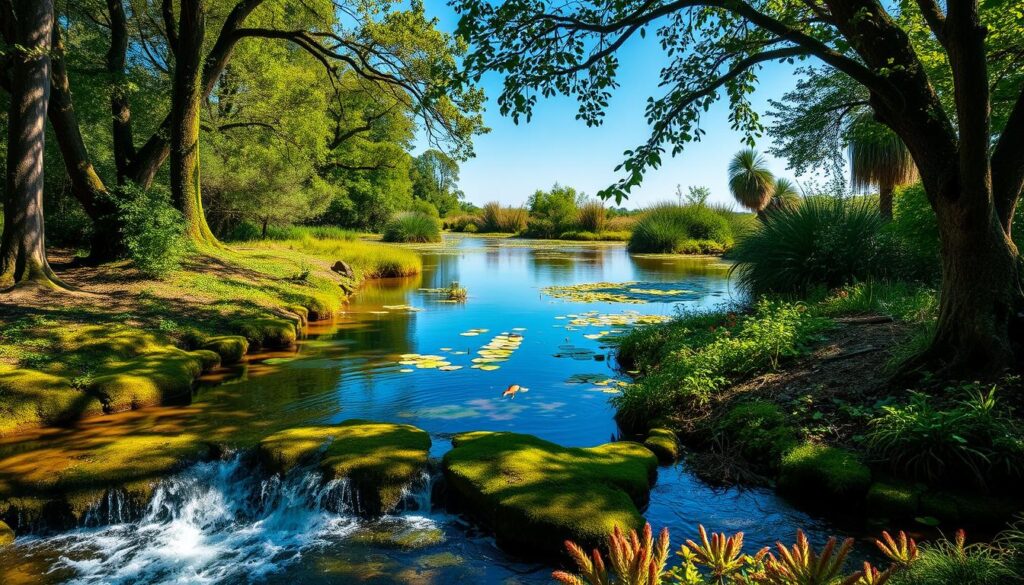
To understand the different water sources better, let’s look at their typical features.
| Water Source | Reliability | Purity | Accessibility |
|---|---|---|---|
| Rivers and Streams | High | Variable | Easy |
| Lakes and Ponds | Moderate | Low | Moderate |
| Rainwater Collection | Variable | High | Dependent on rainfall |
By knowing about the different water sources and their traits, you can make better choices. This ensures you stay hydrated and safe on your outdoor adventures.
Evaluating Water Source Safety
Checking the safety of your water source is key to avoiding waterborne diseases outdoors. Even clear-looking water can have harmful germs, as I found on the Pacific Crest Trail and Continental Divide Trail. Giardia was a big worry there.
To make sure your water is safe, you need to know how to test it and treat it. You must look at several things, like what’s in the water and how well treatments work.
Testing for Contaminants
Testing for contaminants means checking for many kinds of pollutants. This includes bacteria, viruses, protozoa, and chemicals. Here are some ways to do it:
- Look at the water source and its surroundings
- Use water testing kits to find specific pollutants
- Send water samples to a lab for analysis
Understanding Water Treatment Methods
After finding out what’s in the water, you need to treat it. There are a few ways to do this:
- Boiling: Boil water to kill germs
- Filtration: Use filters to remove contaminants
- Chemical Treatment: Add disinfectants like chlorine or iodine
- UV Treatment: Use UV light to kill microorganisms
Knowing and using these methods can greatly lower the risk of getting sick from water. This makes your outdoor adventures safer.
Techniques for Finding Water in the Wild
Finding water in the wild needs knowledge, the right tools, and observation skills. I use both old and new methods to find water. This helps me survive in the wilderness.
Natural Indicators of Water
Nature shows us where water might be. I look for green vegetation and lush foliage. These signs mean water is close by.
Animal tracks and grain-eating birds also point to water. They need it to live. Swarming insects are another clue, as they gather near water.
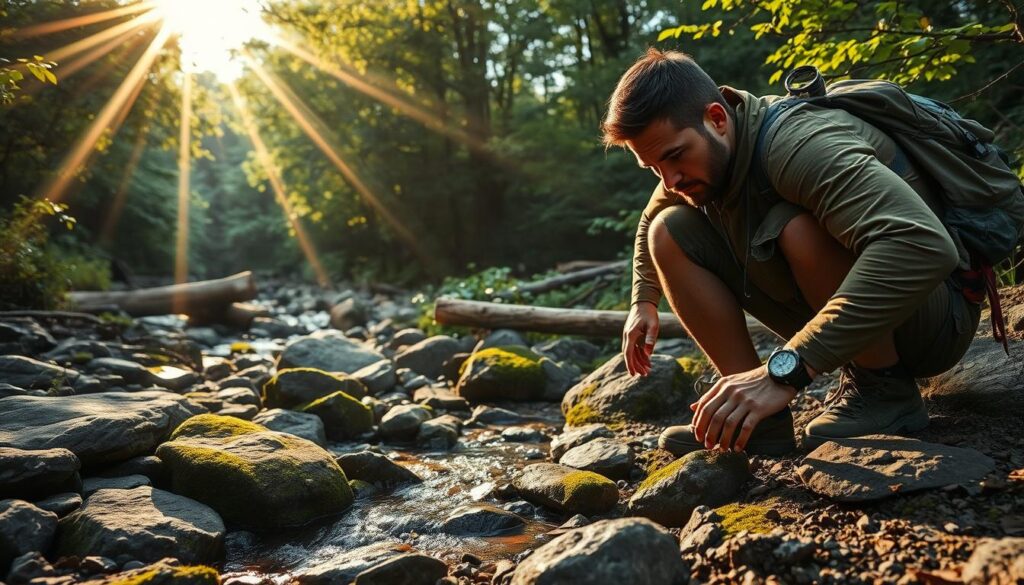
Using Topographical Maps
Topographical maps are key for finding water. They show rivers, lakes, and ponds. By studying these maps, I can find water sources and plan my path.
I also look for valleys or depressions. These areas tend to hold water. It’s a good way to find water.
| Map Feature | Potential Water Source | Relevance |
|---|---|---|
| Rivers and Streams | Flowing Water | High |
| Lakes and Ponds | Standing Water | High |
| Valleys and Depressions | Water Accumulation | Medium |
GPS Tools and Apps
GPS tools and apps also help find water. They show water sources on maps. I can mark water spots for future use.
Apps like these offer topographic maps and waypoint marking. Using these with old methods helps me find water in the wild.
Essential Gear for Water Sourcing
For a great outdoor adventure, knowing your water sourcing gear is key. The right tools are essential for finding safe drinking water on your trips.
Water filtration systems come in many types. Hollow fiber filters, like the Platypus QuickDraw and Sawyer Squeeze, are top picks for hikers. They’re light, strong, and easy to keep up in the wild.
Filtration Systems and Purification Methods
Filtration systems are vital for cleaning water. The Sawyer Mini is a favorite for its small size and ability to filter out harmful stuff.
| Filtration System | Weight | Filter Life | Flow Rate |
|---|---|---|---|
| Platypus QuickDraw | 14 oz | 1000 liters | 1 liter/min |
| Sawyer Squeeze | 2.8 oz | 100,000 gallons | 1 liter/min |
| Sawyer Mini | 2 oz | 300,000 gallons | 1 liter/min |
Purification Tablets
Purification tablets are another good way to keep water safe. They’re light and simple to use, perfect for backpackers. Always follow the instructions on the packaging for the right amount and wait time.
Storage Solutions
Having the right storage solutions is also important. Collapsible water containers and hydration bladders are favorites for their convenience and portability.
Look for storage that’s durable, easy to clean, and doesn’t leak. Good storage keeps your water clean and ensures you have a steady supply.
Legal Considerations When Accessing Water
Finding sustainable water sources means knowing where to look and understanding the law. When I explore outdoor water sources, I must consider the legal aspects.
It’s key to know about water rights and laws, which vary by state in the U.S. This makes it important to study the legal side of water access.
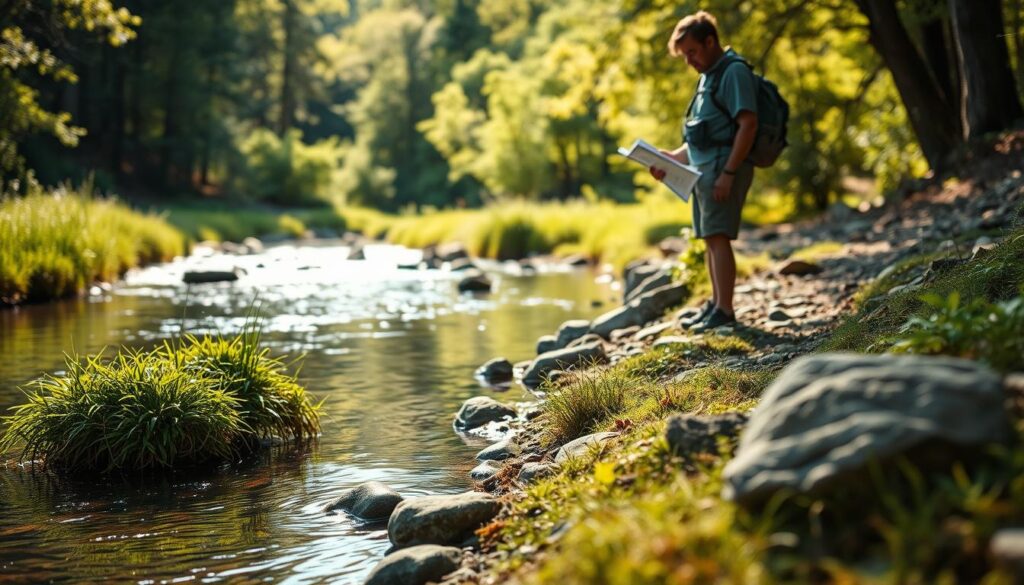
Water Rights in the U.S.
In the U.S., water rights are mainly controlled by state laws, with some federal rules. The first person to use water for a good purpose gets the right to it.
“The concept of prior appropriation has been key in western U.S. water law, where water is often scarce.”
This system can create complex water right orders, which is a big deal in areas with little water. It’s vital to learn about these rights when looking for water sources.
| State | Primary Water Rights Doctrine | Notable Regulations |
|---|---|---|
| California | Prior Appropriation | Strict rules on water diversion |
| Texas | Prior Appropriation and Riparian Rights | Large water users need permits |
| New York | Riparian Rights | Rules on water withdrawals |
Navigating State Regulations
Understanding state rules for water sourcing is a must. This means knowing if a permit is needed for certain water sources.
For example, some states have rules for collecting rainwater, while others limit access to rivers and streams.
- Look up state water laws and rules.
- Get the right permits before collecting water.
- Know what the prior appropriation doctrine means.
Knowing these legal points helps me find outdoor water sources in a way that’s both sustainable and legal.
The Role of Local Ecosystems
Knowing about local ecosystems is key to finding natural water sources. The health of these areas affects water quality and availability. When I’m in the wilderness or my backyard, understanding ecosystems helps me find water.
Impact on Water Quality
Local ecosystems greatly influence water quality. For example, areas with lots of plants have cleaner water because of natural filters. But, pollution or human activity can make water worse.
Several factors affect water quality in local ecosystems:
- Plant species that filter out contaminants
- Soil type and its ability to filter rainwater
- Wildlife impact on water sources
Environmental experts say, “The health of local ecosystems is tied to water purity.” This shows why we must protect these areas.
Identifying Wildlife Indicators
Wildlife can show where water is. For instance, many birds or insects near a spot might mean there’s water. I once saw birds flying to a spot, revealing a hidden stream.
Here are some wildlife signs of water:
- Birds: They drink and bathe in water.
- Insects: Bees and butterflies are near water.
- Large mammals: Deer and elk visit water sources.
By watching for these signs, I can find water outdoors more easily and safely.
Seasonal Variations in Water Sources
Seasons change how we find water outside. Knowing these changes is key for survival or fun trips in the wild.
Changes in Availability
Seasons alter water availability. In the dry season, rivers dry up. But in the wet season, they overflow. It’s important to find other water sources during these times.
In dry areas, water is easier to find in the wet season but scarce in the dry months. You need to be flexible in finding water. This might mean using seasonal water sources or saving water in other ways.
Adapting Techniques Throughout the Year
Changing how you find water with the seasons is essential. Here are some tips:
- Use rainwater systems in the wet season to save water for dry times.
- Look for seasonal water spots like temporary streams or ponds that fill up in the wet season.
- Change how you clean water based on what’s in it during different seasons.
Here’s a table showing how water sources change with the seasons and how to adapt:
| Season | Water Availability | Recommended Techniques |
|---|---|---|
| Wet Season | High | Rainwater harvesting, using surface water sources |
| Dry Season | Low | Conserving stored water, using groundwater sources |
| Spring | Moderate to High | Identifying new water sources, melting snow for water |
Best Practices for Collecting Water
Exploring the wilderness means knowing how to collect water safely and responsibly. It’s not just about our needs; it’s also about protecting the environment. Collecting from sustainable water sources helps keep nature intact.
There are rules to follow when collecting water. These rules help us not harm natural water sources. It’s important to purify water before drinking it to keep the source clean and safe for wildlife.
Ethical Sourcing Guidelines
Ethical sourcing means collecting water wisely. We should not take too much water, as it can harm the environment and other users. Before collecting, I check if the water source can handle it.
- Observe the water source’s flow and volume.
- Use collection methods that minimize disturbance to the surrounding ecosystem.
- Avoid collecting water during peak usage times to prevent depletion.
Minimizing Environmental Impact
When collecting water, we must think about our impact on the environment. It’s not just about collecting water. Simple actions like not littering and respecting wildlife habitats help a lot.
By following these best practices, we can meet our water needs without harming the environment. It’s about finding a balance and caring for our natural water sources for the future.
Emergency Situations and Water Sourcing
In emergency situations, finding water is key to survival. It’s important to know how to find water, whether you’re in a city or the wilderness.
Urban vs. Wilderness Strategies
Finding water in emergencies is different in cities and the wild. Cities use existing water systems, while the wilderness looks for natural water sources.
Urban Strategies:
- Find public water sources like fountains or water mains.
- Use water purification tablets or filters for tap water.
- Collect rainwater from rooftops or other surfaces.
Wilderness Strategies:
- Look for rivers, streams, and ponds.
- Find plants that show where water is.
- Collect dew or rainwater.
Making the Most of Urban Resources
In cities, using what’s available is key. This means knowing how to get and purify water from different sources.
| Urban Water Source | Purification Method | Safety Considerations |
|---|---|---|
| Tap Water | Boiling, Purification Tablets | Check for contamination advisories |
| Rainwater | Filtration, Boiling | Avoid collecting from polluted surfaces |
| Fountains | Purification Tablets, UV Treatment | Check water quality before consumption |
Knowing how to find water in emergencies, whether in a city or the wilderness, helps prepare you. It’s all about using what’s available wisely.
Resources and Tools for Further Learning
I’ve gathered a list of valuable resources to help you learn more about water sourcing. Knowing how to collect water is key for a steady outdoor water supply. There are many books and guides that dive deep into this topic.
Recommended Guides
Some notable guides cover wilderness survival and water purification. They give you the details you need to find water effectively.
Websites and Local Organizations
Online sites focused on outdoor skills share articles on water collection. Local groups and workshops also teach hands-on water sourcing and purification. This helps you get better at finding safe water outdoors.
By checking out these resources, you can learn more about water sourcing. This will help you improve your skills in getting a reliable outdoor water supply.
FAQ
What are the most common sources of outdoor water?
Rivers, streams, lakes, and ponds are common sources of outdoor water. Rainwater collection is also a good way to get water.
How can I evaluate the safety of a water source?
Test the water for contaminants. Use methods like filtration systems or purification tablets to make it safe.
What are some natural indicators of water?
Look for changes in vegetation and animal tracks. Also, watch for insects or birds that live near water.
How do seasonal changes affect water availability?
Seasonal changes can dry up or freeze water sources. Knowing these changes helps you find water better.
What are some best practices for collecting water sustainably?
Follow ethical guidelines and minimize environmental impact. Use methods that protect the ecosystem.
What are my options for water sourcing in urban emergency situations?
Use bottled water or water from faucets if safe. You can also use water filtration systems or purification tablets.
How do local ecosystems impact water quality?
Local ecosystems affect water quality. Factors like vegetation, wildlife, and soil composition play a big role.
What are some recommended resources for learning more about water sourcing?
Check out books and guides on water sourcing. Visit websites on wilderness survival and water techniques. Look for local workshops or organizations for training.
What legal considerations should I be aware of when accessing outdoor water sources?
Know about water rights in the U.S. and state regulations. This helps avoid legal problems when getting water from outdoors.
How can I identify wildlife indicators that lead to water sources?
Look for animal tracks, bird flight patterns, and certain insects. These signs often lead to water sources.
What is the importance of using topographical maps in finding water?
Topographical maps show land layout. They help find water sources by highlighting valleys or depressions where water collects.
How can GPS tools and apps aid in finding water?
GPS tools and apps can locate water sources. They help navigate and track your route to avoid getting lost.

